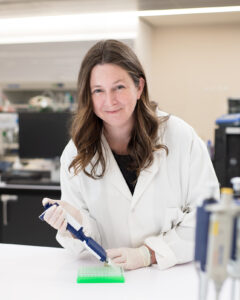 Dr Annabel Whibley, Bragato Research Institute
Dr Annabel Whibley, Bragato Research Institute
The Sauvignon Blanc Grapevine Improvement programme is one step closer to achieving its goal of increasing the resilience of the New Zealand wine industry, with the completion of a reference genome.
Multiple audits of the wine sector have identified our reliance on Sauvignon Blanc and a lack of genetic diversity as one of the biggest risks facing our industry. The Sauvignon Blanc 2.0 project was launched in 2021 with the goal of producing a large population of new Sauvignon Blanc plants, some of which we expect to have beneficial characteristics for the New Zealand market. Importantly for our premium variety, this is to be achieved using methods that do not fall foul of varietal or genetic modification restrictions and which do not rely on the prohibitively expensive import of new plant material to the country.
Bragato Research Institute’s (BRI’s) Grapevine Improvement team has been building capability in cutting-edge genomic sequencing technologies and analytical methods. This month, BRI has reached a key milestone in the project: obtaining a complete and highly accurate reference genome of the Mass Select (UCD1) clone that underpins much of the Sauvignon Blanc planting in New Zealand and which is the genetic background for their work to generate novel diversity.
What is a reference genome?
A reference genome is a foundational resource for genomics analysis and recent years have seen a boom in the availability and quality of reference genome assemblies across the tree of life. A reference genome serves as a catalogue of all the genetic information contained within the genome and from that, we can begin to comprehensively describe and understand the genes and other functional elements that make up an individual. Having a complete and accurate reference also allows scientists to faithfully and comprehensively assess and interpret the significance of genomic differences between individuals and species. Genetic differences between individuals can contribute to differences in agronomically important traits, for example by influencing developmental processes such as the timing of budburst or ripening, or by affecting responses to environmental cues such as specific pathogens or pests or climate conditions.
This valuable genomic resource will now allow the BRI team to comprehensively describe differences between ‘Mass Select’ and other commercially-grown Sauvignon Blanc clones, as well as to characterise bud-sports identified in vineyards and the large diversity panel that will be generated in the Sauvignon Blanc 2.0 project.
Long read sequencing developments
Although the Human Genome Project officially concluded in 2003, the draft remained obstinately incomplete. The final barriers to completion were overcome in 2022 by technological developments in the field, the most important of which was the arrival of so-called long-read sequencing methods. By increasing the length of contiguous bases that could be read in one go from just a few hundred to tens of thousands (sometimes even more), complex tangles of repetitive patterns could finally be resolved: the missing 8% of the human genome was accounted for, a few thousand new genes were identified, and hundreds of errors and gaps were corrected and filled. Genomes are organised into units called chromosomes within the cell and these could now be recovered fully in their linear end-to-end sequence and with this the field of genomics entered the so-called telomere-totelomere (T2T) age (although it was another year before the small but especially challenging human Y chromosome was also resolved in this way).
Sequencing Sauvignon Blanc
At BRI we are using the same approaches as the Human T2T consortium to generate a high-quality reference for Sauvignon Blanc. Whilst the human genome contains 3.1 billion nucleotides split across 23 chromosomes, the grapevine genome is a more modest 500 million nucleotides across 19 chromosomes. Although the compactness of the genome is helpful, plant genomes have other challenging features – notably an increased amount of repetitive sequences and higher levels of what is termed ‘heterozygosity’, which describes how the two copies of the genome contained with the plant cells differ from each other. To date, just a handful of plant genomes have achieved telomere-to-telomere status.
The genomics research at BRI is underpinned by the powerful Oxford Nanopore Technologies PromethION sequencing platform and high-performance computing resources provided by the New Zealand eScience Infrastructure (NeSI). Two of BRI’s scientists, Dr Bhanupratap Vanga and Dr Amy Hill, have optimised the extraction of DNA from leaf tissue, recovering stretches of DNA thousands to hundreds of thousands of base pairs in length from the sequencer. These long and highly accurate sequences are the raw material for complex assembly algorithms to resolve millions of segments of DNA sequence (in total comprising over 50 billion of nucleotide bases) into linear chromosome sequences. As BRI’s Bioinformatician, I have been able to obtain a reference genome that comprises T2T sequences of both copies of each chromosome.
Where to from here: How will we use the reference genome?
This valuable genomic resource will now allow the BRI team to comprehensively describe differences between ‘Mass Select’ and other commercially-grown Sauvignon Blanc clones, as well as to characterise bud-sports identified in vineyards and the large diversity panel that will be generated in the Sauvignon Blanc 2.0 project.
Identifying differences is just part of the process, though, and big data is also central to our ability to interpret the significance of the differences we discover. In June, I was able to participate in the European COST Action Grapedia Training School at the Fondazione Edmund Mach in San Michele all’Adige, Italy. This consortium of scientists is generating openly-available resources in grapevine in order to construct an information hub that aims to simplify the journey from the identification of genomic differences to actionable biological insights for the wine industry.
About the programme
The Sauvignon Blanc Grapevine Improvement Programme is a seven year research programme funded by the Ministry for Primary Industries’ Sustainable Food and Fibre Futures fund, New Zealand Winegrowers via the industry levy, and individual industry participants.

















